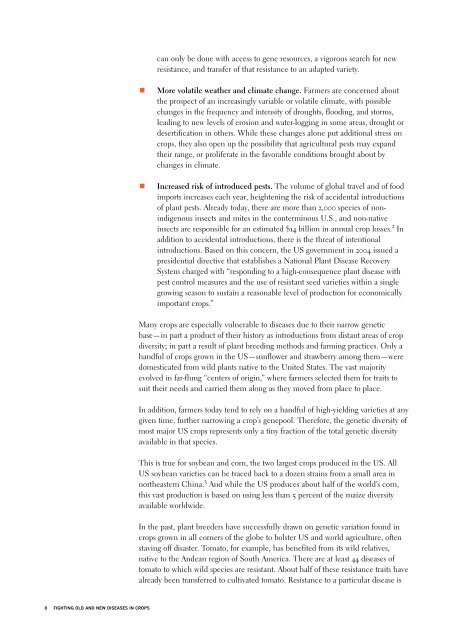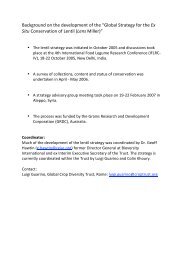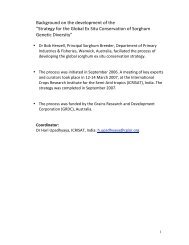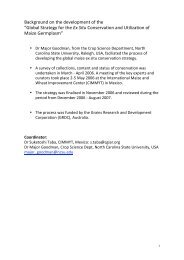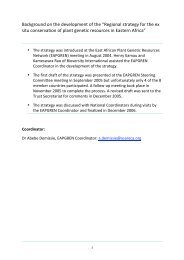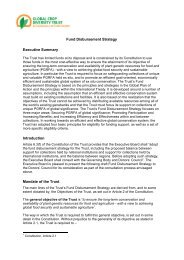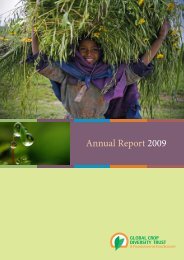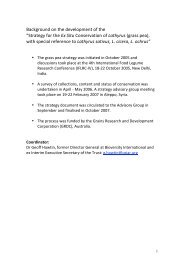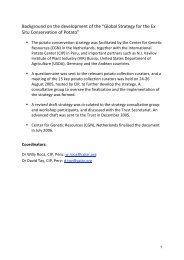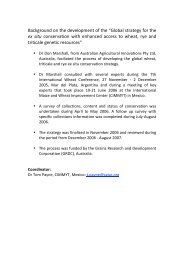Safeguarding the Future of US Agriculture - Global Crop Diversity Trust
Safeguarding the Future of US Agriculture - Global Crop Diversity Trust
Safeguarding the Future of US Agriculture - Global Crop Diversity Trust
Create successful ePaper yourself
Turn your PDF publications into a flip-book with our unique Google optimized e-Paper software.
can only be done with access to gene resources, a vigorous search for newresistance, and transfer <strong>of</strong> that resistance to an adapted variety.More volatile wea<strong>the</strong>r and climate change. Farmers are concerned about<strong>the</strong> prospect <strong>of</strong> an increasingly variable or volatile climate, with possiblechanges in <strong>the</strong> frequency and intensity <strong>of</strong> droughts, flooding, and storms,leading to new levels <strong>of</strong> erosion and water-logging in some areas, drought ordesertification in o<strong>the</strong>rs. While <strong>the</strong>se changes alone put additional stress oncrops, <strong>the</strong>y also open up <strong>the</strong> possibility that agricultural pests may expand<strong>the</strong>ir range, or proliferate in <strong>the</strong> favorable conditions brought about bychanges in climate.Increased risk <strong>of</strong> introduced pests. The volume <strong>of</strong> global travel and <strong>of</strong> foodimports increases each year, heightening <strong>the</strong> risk <strong>of</strong> accidental introductions<strong>of</strong> plant pests. Already today, <strong>the</strong>re are more than 2,000 species <strong>of</strong> nonindigenousinsects and mites in <strong>the</strong> conterminous U.S., and non-nativeinsects are responsible for an estimated $14 billion in annual crop losses. 2 Inaddition to accidental introductions, <strong>the</strong>re is <strong>the</strong> threat <strong>of</strong> intentionalintroductions. Based on this concern, <strong>the</strong> <strong>US</strong> government in 2004 issued apresidential directive that establishes a National Plant Disease RecoverySystem charged with “responding to a high-consequence plant disease withpest control measures and <strong>the</strong> use <strong>of</strong> resistant seed varieties within a singlegrowing season to sustain a reasonable level <strong>of</strong> production for economicallyimportant crops.”Many crops are especially vulnerable to diseases due to <strong>the</strong>ir narrow geneticbase—in part a product <strong>of</strong> <strong>the</strong>ir history as introductions from distant areas <strong>of</strong> cropdiversity; in part a result <strong>of</strong> plant breeding methods and farming practices. Only ahandful <strong>of</strong> crops grown in <strong>the</strong> <strong>US</strong>—sunflower and strawberry among <strong>the</strong>m—weredomesticated from wild plants native to <strong>the</strong> United States. The vast majorityevolved in far-flung “centers <strong>of</strong> origin,” where farmers selected <strong>the</strong>m for traits tosuit <strong>the</strong>ir needs and carried <strong>the</strong>m along as <strong>the</strong>y moved from place to place.In addition, farmers today tend to rely on a handful <strong>of</strong> high-yielding varieties at anygiven time, fur<strong>the</strong>r narrowing a crop’s genepool. Therefore, <strong>the</strong> genetic diversity <strong>of</strong>most major <strong>US</strong> crops represents only a tiny fraction <strong>of</strong> <strong>the</strong> total genetic diversityavailable in that species.This is true for soybean and corn, <strong>the</strong> two largest crops produced in <strong>the</strong> <strong>US</strong>. All<strong>US</strong> soybean varieties can be traced back to a dozen strains from a small area innor<strong>the</strong>astern China. 3 And while <strong>the</strong> <strong>US</strong> produces about half <strong>of</strong> <strong>the</strong> world’s corn,this vast production is based on using less than 5 percent <strong>of</strong> <strong>the</strong> maize diversityavailable worldwide.In <strong>the</strong> past, plant breeders have successfully drawn on genetic variation found incrops grown in all corners <strong>of</strong> <strong>the</strong> globe to bolster <strong>US</strong> and world agriculture, <strong>of</strong>tenstaving <strong>of</strong>f disaster. Tomato, for example, has benefited from its wild relatives,native to <strong>the</strong> Andean region <strong>of</strong> South America. There are at least 44 diseases <strong>of</strong>tomato to which wild species are resistant. About half <strong>of</strong> <strong>the</strong>se resistance traits havealready been transferred to cultivated tomato. Resistance to a particular disease is8 FIGHTING OLD AND NEW DISEASES IN CROPS


